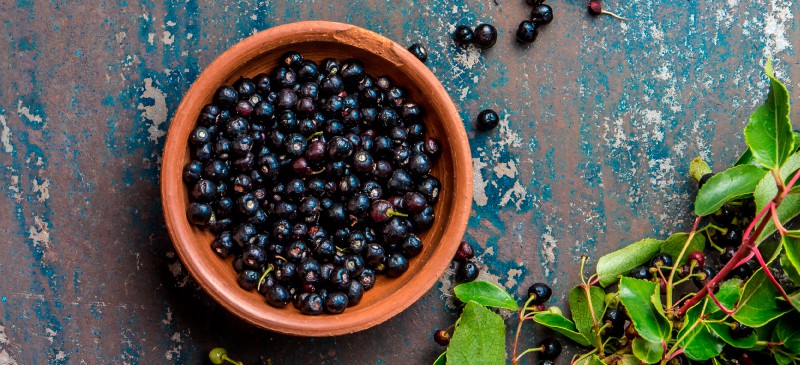
South America, including places like Chile, Argentina and Patagonia, is home to a variety of berry species that are packed with nutrients. One example is maqui berry, a dark purple-black berry that has many things in common with other “superfood” berries like acai berry.
These berries have been used by Mapuche Indians living in Chile for centuries as a traditional medicine against conditions including fever, joint pain, throat diseases, slow healing wounds and diarrhea.
Today we know that maqui berry benefits — such as supporting healthy skin, eyes, and a well-functioning brain and heart — are due to its rich supply of antioxidants and anti-inflammatory compounds, especially polyphenols.
What Is Maqui Berry?
Maqui berry (Aristotelia chilensis) is a type of nutrient-rich berry native to Southern Chile that is now made into dried powder and other supplements. These berries grow on a small, evergreen tree in the Elaeocarpaceae family that is also called Chilean wineberry.
While it’s most convenient to consume maqui berry (MB) in powder or capsule form, you can also drink its juice and eat the whole berries. However, the fresh berries are not available in most parts of the world because they are hard to transport, so most people choose to consume MB as a dietary supplement.
Benefits
What is maqui berry good for? This berry offers widespread benefits for different parts do the body, including the immune, cardiovascular and central nervous systems, due to its antioxidant and anti-inflammatory properties.
It’s considered a “functional food” because it’s especially high in protective compounds like anthocyanins like delphinidin, flavonoids and ellagic acid, the same types that are found in other superfoods such as blueberries, red wine, pomegranate, currants and cherries.
In fact, certain studies have found that MB is even better at defending against oxidative stress than other common berries, such as strawberries, blackberries and blueberries.
Not only does maqui have antioxidant effects, but it’s thought to possess antidiabetic and antiviral activities.
Below is more about some of the main maqui berry benefits:
1. Supports Metabolic Health
Studies have found that MB positively affects carbohydrate metabolism and glucose metabolism, particularly due to its high levels of the compound delphinidin.
Among adults with prediabetes and type 2 diabetes, MB may help normalize fasting blood glucose and insulin levels. Delphinol from MB has been found to be generally well-tolerated and unlikely to cause adverse effects among those with metabolic issues.
2. Can Promote Cardiovascular Health
Because maqui has powerful free radical-trapping potential and high antioxidant capacity, it’s capable of defending the body against harmful effects of high cholesterol.
One study found that supplementation with MB extract daily for 12 weeks lowered LDL (“bad”) cholesterol and increased HDL (“good”) cholesterol in adults, while protecting blood vessels against damage due to oxidative stress and inflammation.
3. Helps Maintain Healthy Skin and Eyes
Fruits and veggies that are high in antioxidants are great for defending skin against age-related damage and other conditions, potentially including skin cancer. A high-antioxidant diet is also protective of vision and fights cellular damage that can harm the eyes.
READ RELATED: This Omega-3-Rich Banana Breakfast Smoothie Recipe Tastes (and Looks) Like Tropical Sunshine
Is maqui berry good for dry eyes? One small study suggests that it is after finding that adults with dry eyes who took 60 milligrams of MB extract daily for 60 days experienced significant improvements in symptoms.
After two months of supplementation, MB led to increased tear fluid production, which helps reduce dry eye irritation. Researchers believe that maqui helps restore normal eye fluid production due to its ability to to fight oxidative stress, which can damage glands in the eyes.
4. May Help Reduce Pain and Arthritis Symptoms
Because it can help ease inflammation, MB can be beneficial for those suffering from rheumatoid arthritis and joint pain.
It’s also been traditionally used to reduce swelling, dysentery, sore throats and a number of other inflammatory conditions related to poor immune function.
Additionally, leaves from the maqui plant have long been used to make dressings that are applied to slow healing wounds.
How to Add to Diet (Recipes)
MB is available in powder, capsule, extract and juice form, which you can find in health food stores or online. In parts of the world such as Chile and Patagonia, you may also be able to find fresh maqui berries.
Because levels of antioxidants present in fruits and vegetables typically decline quickly after they are harvested, it may be best to opt for powders and juices that contain higher levels of these compounds compared to berries that have undergone long periods of transport.
What does maqui berry taste like? Many people describe the berries as having a taste that’s similar to blackberries.
MBs are smaller than blackberries however and contain a bunch of seeds inside. The berries can be eaten raw or cooked, and they are often processed by drying and grinding them.
How can these berries be used? You can add MB to your diet by mixing the powder or juice into water or adding some to smoothies, oatmeal, yogurt, and healthy baked goods and desserts.
You can use the powder similarly to how you’d use acai, such as making granola bowls. Other traditional uses for MB include brewing wine and chicha, a Chilean alcoholic beverage.
Here are some healthy maqui berry recipes to try at home:
Risks and Side Effects
Maqui berry seems to be safe overall to consume in both food/juice form and as a supplement, as long as you stick with recommended dosages. High amounts may possibly lead to side effects, such as indigestion and changes in blood sugar.
Because MB can affect cholesterol, blood glucose and insulin levels, it’s possible that supplementation may interfere with the effects of some cholesterol and diabetes medication. Speak with your doctor about a safe level to supplement with if you take any daily medications.
Conclusion
- Maqui (Aristotelia chilensis) is an evergreen plant native to Chile that produces antioxidant-rich purple berries. Most often these berries are consumed as dried powder, juiced, or taken in extract or capsule form.
- Due to their rich content of polyphenols and other protective compounds, maqui berry benefits include supporting metabolic, cardiovascular and immune function, as well as protecting the eyes, brain and blood vessels from damage.
- MB is available in powder, capsule, extract and juice forms. You can also eat the berries both raw or cooked, such as in smoothies, baked goods, energy balls and granola bowls.
Source: Dr. Axe | Nutrition





